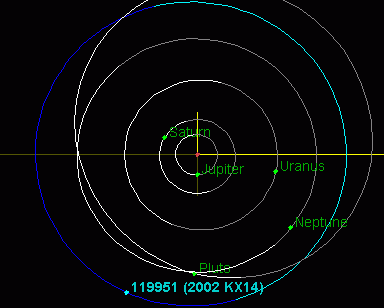(119951) 2002 KX14

| Demi-grand axe (a) | 5,79 × 109 km (38,701 ua) |
|---|---|
| Périhélie (q) | 5,52 × 109 km (36,894 ua) |
| Aphélie (Q) | 6,06 × 109 km (40,508 ua) |
| Excentricité (e) | 0,047 |
| Période de révolution (Prév) | 88 152 ± 21 j (241,35 a) |
| Inclinaison (i) | 0,4° |
| Longitude du nœud ascendant (Ω) | 286,7° |
| Argument du périhélie (ω) | 75,8° |
| Anomalie moyenne (M0) | 251,1° |
| Catégorie | transneptunien |
| Dimensions | 562 +220 −182 km [2] 455 km[3] 468 km[4] |
|---|---|
| Magnitude absolue (H) | 4,71[1] 4,9[3] |
| Albédo (A) | 0,10[3] 0,124[4] |
| Plus ancienne observation de pré-découverte | |
|---|---|
| Date | |
| Découvert par | C. Trujillo, M. E. Brown |
| Lieu | Palomar |
| Désignation | 2002 KX14 |
(119951) 2002 KX14 est un objet transneptunien d'environ 500 km de diamètre.
Orbite
[modifier | modifier le code]L'orbite[5] de 2002 KX14 possède un demi-grand axe de 38,701 ua et une période orbitale d'environ 241 ans. Son périhélie l'amène à 36,894 ua du Soleil et son aphélie l'en éloigne de 40,508 ua.
Il a été en opposition en avec une magnitude de 20,4[6],[7], ce qui le rend 360 fois plus faible que Pluton[8].

Découverte
[modifier | modifier le code](119951) 2002 KX14 a été découvert le [5].
Références
[modifier | modifier le code]- (en) Caractéristiques et simulation d'orbite de 119951 dans la JPL Small-Body Database.
- Stansberry, John; et al. (2007). "Physical Properties of Kuiper Belt and Centaur Objects: Constraints from Spitzer Space Telescope". arXiv:astro-ph/0702538 [astro-ph].
- (en) Michael E. Brown, « How many dwarf planets are there in the outer solar system? (updates daily) », California Institute of Technology (consulté le )
- (en) « Liste des objets transneptuniens », sur www.johnstonsarchive.net, (consulté le )
- (en) « List Of Transneptunian Objects », The Minor Planet Center (MPC) (consulté le )
- "(119951) 2002 KX14". (epoch) Minor Planet Center. 2010-07-23. Retrieved 2010-10-24.
- HORIZONS Web-Interface". JPL Solar System Dynamics. Retrieved 2008-07-20
- (Racine cinquième de 100)^(20,4-14) = 363
Annexes
[modifier | modifier le code]Articles connexes
[modifier | modifier le code]Liens externes
[modifier | modifier le code]- (en) Caractéristiques et simulation d'orbite de 119951 dans la JPL Small-Body Database.
- (en) Minor Planet Center database

